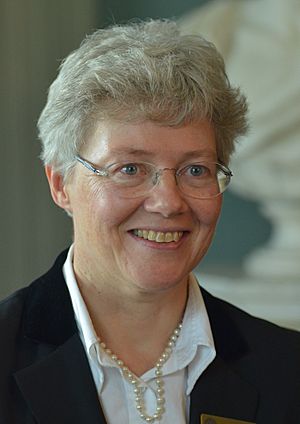Anne L'Huillier facts for kids
Quick facts for kids
Anne L'Huillier
KmstkNO
|
|
|---|---|

L'Huillier in 2012
|
|
| Born | 16 August 1958 |
| Education | École Normale Supérieure, Fontenay-aux-Roses (BA) Pierre and Marie Curie University (MSc, PhD) |
| Known for | High harmonic generation, attosecond physics |
| Spouse(s) | Claes-Göran Wahlström |
| Children | 2 |
| Awards | UNESCO L'Oréal Award (2011) BBVA Foundation Frontiers of Knowledge Award (2022) Wolf Prize in Physics (2022) Nobel Prize in Physics (2023) |
| Scientific career | |
| Fields | Attosecond physics |
| Institutions | Lund University |
| Thesis | Ionisation Multiphotonique et Multielectronique (Multiphoton and Multielectron Ionization) (1986) |
| Doctoral advisor | Bernard Cagnac |
Anne Geneviève L'Huillier (born August 16, 1958) is a French physicist. She is a professor of atomic physics at Lund University in Sweden.
She leads a research group that studies attosecond physics. This field looks at how electrons move in real time. This helps scientists understand chemical reactions at a very tiny level. Her work helped create the field of attochemistry.
In 2003, her group set a world record for the shortest laser pulse. It lasted only 170 attoseconds. An attosecond is an incredibly short amount of time, like a billionth of a billionth of a second!
L'Huillier became a member of the Royal Swedish Academy of Sciences in 2004. She has won many awards for her work in physics. These include the Wolf Prize in Physics in 2022 and the Nobel Prize in Physics in 2023.
Contents
Life and Education
Early Life and Studies
Anne L'Huillier was born in Paris, France, in 1958. She earned two master's degrees, one in theoretical physics and one in mathematics.
For her doctorate degree, she switched to experimental physics. She studied at Pierre and Marie Curie University. Her research focused on how lasers interact with atoms at very high power. She did this research near Paris.
Her Career Journey
After finishing her doctorate, L'Huillier worked in different places. She was a researcher at the Chalmers Institute of Technology in Gothenburg, Sweden. She also worked at the University of Southern California in the United States.
In 1986, L'Huillier got a permanent job as a researcher in France. In 1992, she joined an important experiment in Lund, Sweden. This experiment used a special laser system. In 1994, she moved to Sweden for good. She became a lecturer at Lund University in 1995 and a full professor in 1997.
Amazing Research in Attosecond Physics
Creating Super-Fast Light Pulses
Anne L'Huillier's research is about creating and using extremely short light pulses. These pulses are in the ultraviolet range and last only tens or hundreds of attoseconds. This process is called high harmonic generation.
In 1987, L'Huillier made an important discovery. She found that when gases like argon were hit by a laser, they would glow. They would also give off extra light at different frequencies.
Understanding Electron Movement
L'Huillier uses these attosecond light sources to study how electrons move. Electrons are tiny particles inside atoms and molecules. They move incredibly fast. These attosecond sources are like the world's fastest cameras. They use super-short light pulses to "see" electrons as they move or change energy.
In 2003, her group broke the world record for the shortest laser pulse. It lasted only 170 attoseconds. Her methods have opened up a new field called attochemistry. This field allows scientists to study how electrons behave during chemical reactions.
In 2017, L'Huillier's group solved a puzzle in physics. They helped explain why some earlier experiments about electrons didn't match theories. Their work helped scientists better understand how electrons behave.
Awards and Recognition
Anne L'Huillier has received many important awards for her groundbreaking work.
- From 2007 to 2015, she was part of the Nobel Committee for Physics.
- She became a member of the Swedish Academy of Sciences in 2004.
- In 2011, she received a UNESCO L'Oréal Award. This award celebrates women in science.
- In 2018, she was chosen as a foreign associate of the National Academy of Sciences in the U.S.
- In 2019, she won the Prize for Fundamental Aspects of Quantum Electronics and Optics. This was from the European Physical Society.
Major Awards
- In 2021, L'Huillier received the Max Born Award. This was for her "pioneering work in ultrafast laser science and attosecond physics."
- In 2022, she was awarded the Wolf Prize in Physics. She shared this prize with Ferenc Krausz and Paul Corkum. They were recognized for their work in ultrafast laser science.
- Also in 2022, the three scientists received the BBVA Foundation Frontiers of Knowledge Award.
- In September 2023, she received the Berthold Leibinger Zukunftspreis.
- In October 2023, she was awarded the Nobel Prize in Physics. She shared it with Ferenc Krausz and Pierre Agostini. They won for their methods to create attosecond light pulses. These pulses are used to study how electrons move in matter.
Special Honors

 Sweden: She received the Royal Order of the Polar Star in Sweden on March 21, 2024.
Sweden: She received the Royal Order of the Polar Star in Sweden on March 21, 2024.
 France: She was made a Knight of the Legion of Honour in France on December 29, 2022.
France: She was made a Knight of the Legion of Honour in France on December 29, 2022.- In November 2023, she received an honorary degree from Paris-Saclay University.
- In March 2024, she received another honorary degree from the University of Bordeaux.
- In May 2024, she received an honorary degree from the University of Porto.
Personal Life
Anne L'Huillier is married to Claes-Göran Wahlström. He is also a professor at Lund University. They have two children.
See also
 In Spanish: Anne L'Huillier para niños
In Spanish: Anne L'Huillier para niños

